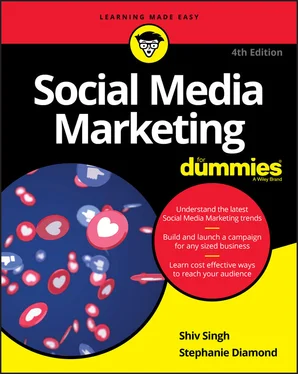A positional influencer is closest to both the purchasing decision and to the consumer. Called peer influencers sometimes, they are typically family members or part of the consumer’s inner circle. They influence purchasing decisions most directly at the point of purchase and have to live with the results of their family member’s or friend’s decision as well.
As Shiv says, “I know that I can’t make a high-consideration purchase like a car purchase without discussing it with my wife. Invariably, she’ll drive the car, too, and sit in it as much as I will. It is as much her purchase as it is mine. Her opinion matters more than anyone else’s in this case. After all, I need to discuss with her the relative pricing of the cars available and whether one is more suitable for our family versus another.” This person derives her influence from her relative position and duties in relation to the actual consumer. She’s closest to the purchasing decision and to the consumer and, therefore, has the most social influence.
Influencing on digital platforms
As we discuss earlier in the chapter, social influence impacts every purchasing decision and always has in some form or other. Each time people make purchasing decisions, they ask each other for advice. Sometimes they depend upon an expert’s guidance, and in other cases, that advice comes from people they know.
So why is influence such a big deal today? This is because Internet consumption, and social media consumption specifically, have hit the mainstream. For example, as of June 2019, the social network platform Facebook had 2.41 billion users worldwide, giving it a population larger than any single country in the world, including China and India. That’s a lot of people talking about a lot of things (including products) to a lot of people! But there’s more to it than that. Social media traffic referrals have risen dramatically in the last few years. Facebook, Pinterest, Instagram, and Twitter have 18 percent, 7.5 percent, 0.73 percent, and 0.73 percent, respectively, of global referrals per Shareaholic (February 2018). These numbers show how much people are also acting on the influence of others — they’re visiting the websites that they’re being told to visit.
People are making more and more purchasing decisions online every day. It’s as natural to buy a product online as it is to go into a physical store. People buy clothes and shoes online, not to mention high-consideration items such as computers, cars (yes, cars), and jewelry. But that’s not all. Not only are consumers buying online, but thanks to social media, they’re also conversing, socializing, and influencing each other online on a scale never seen before.
Call it a shift in web behavior, but the way people make decisions in the real world is finally moving to the Internet in a big way. The social media platforms such as Facebook, Instagram, Snapchat, LinkedIn, Twitter, and YouTube (shown in Figure 1-4), are just a few of the places where people are asking each other for advice and guidance as they make purchasing decisions. Smart companies are realizing that they should no longer design their e-commerce websites to convince buyers to make purchasing decisions in isolation. Rather, they need to design the websites to allow consumers to bring their social influencers into the decision-making process. As consumers, people expect and want that because that’s how they’re used to making their purchasing decisions. That’s why social media marketing matters today. People are influencing and are being influenced by each other every day on the social network platforms, community websites, and destination sites.

FIGURE 1-4:YouTube.
 You may need to put a lot of effort into convincing your managers how important the social media platforms are. The best way to communicate these ideas and techniques to your staff is by organizing lunch-and-learn sessions and bringing in external speakers who can walk your managers through the major social platforms and how best to market on them. Sharing case studies from other brands always resonates well and goes a long way to establishing credibility.
You may need to put a lot of effort into convincing your managers how important the social media platforms are. The best way to communicate these ideas and techniques to your staff is by organizing lunch-and-learn sessions and bringing in external speakers who can walk your managers through the major social platforms and how best to market on them. Sharing case studies from other brands always resonates well and goes a long way to establishing credibility.
Comparing Social Media Marketing with Other Marketing Efforts
It isn’t enough to deploy social media marketing in isolation of every other marketing effort. If you do, you’re sure to fail. Your customers will notice that you have a disjointed, conflicted story — depending on where and how you’re interacting with them. Therefore, it’s important to understand how you can integrate your social media marketing within your other, more traditional marketing — direct mail, public relations, display advertising, and promotions.
 Some of the social media marketing philosophies are in conflict with traditional public relations, media buying, direct mail, and promotions tactics. It’s no use damning those forms of marketing and alienating your peers who focus on those areas. Put extra effort in partnering with your fellow employees as you practice these marketing techniques. Explain what you’re doing, why you’re doing it, and how it complements their efforts. If you discredit the other forms of marketing and the people behind them, it only hurts you in the long run.
Some of the social media marketing philosophies are in conflict with traditional public relations, media buying, direct mail, and promotions tactics. It’s no use damning those forms of marketing and alienating your peers who focus on those areas. Put extra effort in partnering with your fellow employees as you practice these marketing techniques. Explain what you’re doing, why you’re doing it, and how it complements their efforts. If you discredit the other forms of marketing and the people behind them, it only hurts you in the long run.
Direct mail is about managing an active customer database and marketing to members of that database via circulars, catalogs, credit card applications, and other merchandising materials delivered to homes and businesses. You’ve probably gotten a lot of direct mail over the years — perhaps mountains of it — and at some point, you’ve probably wished that these companies would stop mailing you. That’s all direct mail, and whether you like it or not, direct mail has been a very successful form of marketing. The catalog industry has logged billions of dollars in sales because of it.
However, that has been impacted by social media marketing. Of all the areas of marketing, direct mail is one that will be most affected in the long run. Before you start worrying that your mail carrier will stuff your mailbox (or your email inbox through e-mail marketing) even more than usual, consider this: Direct mail is most successful when the mail is targeted and personalized. That means it’s reaching the people who really care about the offers (or are most likely to take advantage of them), and it’s personalized toward the recipients’ needs in a voice and style that’s appealing to them. Pretty straightforward, isn’t it?
Direct mail is as successful as the marketer’s customer database. The database should contain names and addresses of people who are open to receiving direct mail. But when people stop trusting the marketing efforts of large corporations and instead switch to each other for advice, that’s when direct mail loses its power. Statistically, we know that consumers are now more likely to depend on each other for advice and information than they are on the corporations that are marketing to them.
With consumers who are even more connected to each other through social media than before, it has gotten easier for them to reach out to one another for that advice. That means that when they see a piece of direct mail, they’re less likely to depend on it. They’d rather go online and ask a friend for advice or search for a product online than look at that flyer in the mail. And as marketers harness social media marketing tactics more, it could see further drops.
Читать дальше


 You may need to put a lot of effort into convincing your managers how important the social media platforms are. The best way to communicate these ideas and techniques to your staff is by organizing lunch-and-learn sessions and bringing in external speakers who can walk your managers through the major social platforms and how best to market on them. Sharing case studies from other brands always resonates well and goes a long way to establishing credibility.
You may need to put a lot of effort into convincing your managers how important the social media platforms are. The best way to communicate these ideas and techniques to your staff is by organizing lunch-and-learn sessions and bringing in external speakers who can walk your managers through the major social platforms and how best to market on them. Sharing case studies from other brands always resonates well and goes a long way to establishing credibility. Some of the social media marketing philosophies are in conflict with traditional public relations, media buying, direct mail, and promotions tactics. It’s no use damning those forms of marketing and alienating your peers who focus on those areas. Put extra effort in partnering with your fellow employees as you practice these marketing techniques. Explain what you’re doing, why you’re doing it, and how it complements their efforts. If you discredit the other forms of marketing and the people behind them, it only hurts you in the long run.
Some of the social media marketing philosophies are in conflict with traditional public relations, media buying, direct mail, and promotions tactics. It’s no use damning those forms of marketing and alienating your peers who focus on those areas. Put extra effort in partnering with your fellow employees as you practice these marketing techniques. Explain what you’re doing, why you’re doing it, and how it complements their efforts. If you discredit the other forms of marketing and the people behind them, it only hurts you in the long run.










